Topic 9: Intro to Metabolism
1/45
Earn XP
Description and Tags
Name | Mastery | Learn | Test | Matching | Spaced |
|---|
No study sessions yet.
46 Terms
Metabolism
def: All biochemical reactions occurring in a living organism
A. Biochemistry is concerned with understanding their reactants, products, mechanisms, catalysis, kinetics, regulation, & outcomes
3 Major Goals of Metabolism
Goal #1 is extraction of G (usually in form of ATP) & reducing power (usually in form of NADPH) from metabolic fuel
A. These can be utilized for synthesis of complex biomolecules & to perform all necessary biochemical, cellular, & physiological work
Goal #2 is biosynthesis of bio-macromolecules & other nondietary biomolecules
III. Goal #3 is protection of internal homeostasis (i.e., cellular homeostasis, tissue homeostasis, organ homeostasis, body homeostasis)
4 Processes used to meet metabolisms goals
I. Process #1 is metabolic fuel oxidation to generate G & reducing power
II. Process #2 is storage of metabolic fuel for future use & mobilization in times of need
III. Process #3 is biosynthesis of biomolecules
IV. Process #4 is detoxification & disposal of waste products, particularly xenobiotics (i.e., foreign molecules) & compounds formed from metabolic
reactions
Characteristics of Metabolism
Most biochemical reactions are linked in sequence—the product of one becomes the substrate for the next.
Metabolic pathway: Series of reactions where the starting substrate is different from the final product (e.g., glycolysis: glucose → pyruvate).
Metabolic cycle: Series of reactions where the starting substrate and final product are the same molecule (e.g., citric acid cycle).
Metabolic spiral: Reactions repeat in a cycle, each time producing a product that differs from the original reactant in a set way (e.g., fatty acid beta-oxidation removes 2 carbons per round).
Pathways are controlled by enzymes and feedback mechanisms for homeostasis.
End products may be used immediately, start new pathways, or be stored.
Characteristics of Metabolism pt 2
Metabolite
A. Any reactant, intermediate, or product of a
metabolic reaction
II. All metabolic reactions are catalyzed by
enzymes
A. All metabolic reactions are
thermodynamically favorable
1. Enzymes are necessary so that they
occur at life-sustaining speeds 7
types of Metabolic rxns
Because all metabolic reactions are catalyzed
by enzymes, types of biochemical reactions
that occur are dependent on types of
enzymes present
A. 7 major types of metabolic reactions
correspond to the 7 major enzymes classes
Catabolism and anabolism
Method of extracting molecules (1) catabolic
Opp. Take smaller molecules to make larger more complex ones , need free energy to do it- anabolic
They’re united by energy and reducing power- atp, Nadh, nadph ( these unite the two process)
If one stop the other will stop, vice versa
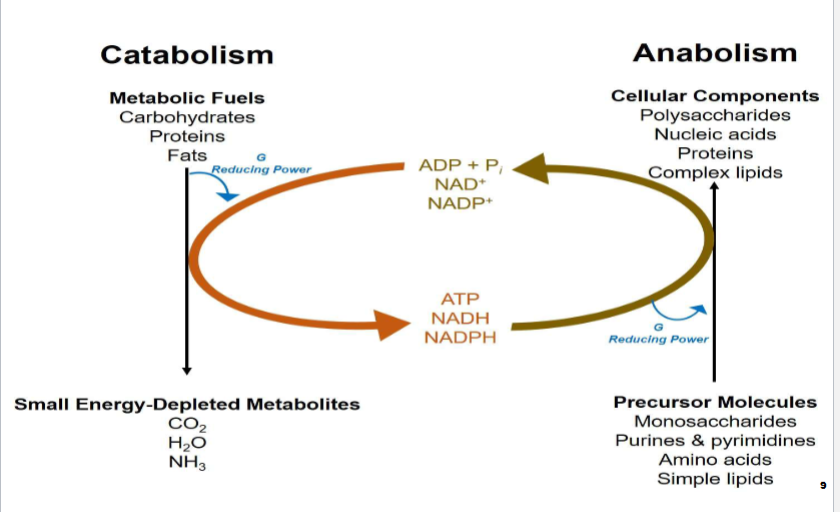
Metabolic Fuels
I. Biomolecules utilized as sources of energy
A. Their oxidation leads to extraction of energy & its capture in
high-energy bonds of ATPB. 7 major metabolic fuels used in human body:
1. Glucose & other monosaccharides (e.g., fructose & galactose)
2. Fatty acids
3. Glycerol
4. Amino acids
5. Ketone bodies
6. Lactate
7. Ethanol
Fuel metabolism (with organ pic)
Main Organs: Liver (carbohydrate metabolism), muscle, and adipose tissue
Storage:
Liver & muscle: Glucose stored as glycogen
Adipose: Fatty acids and glycerol stored as triglycerides
Transport & Utilization:
Glucose & Pyruvate:
Glucose is transported in blood, enters cells for energy via glycolysis
Liver releases glucose when needed, muscle uses glycogen for energy
Pyruvate forms from glycolysis; can become lactate under low oxygen (anaerobic), lactate can be recycled to glucose (Cori cycle)
Pyruvate can also be converted back to glucose (gluconeogenesis)
Amino Acids (Muscle): Oxidized to pyruvate or acetyl-CoA for energy
Triglycerides (Adipose): Broken down as needed; fatty acids released to tissues for use, glycerol converted to pyruvate, then acetyl-CoA
Ethanol: Transported and converted to acetyl-CoA in adipose
Ketone Bodies: Made from acetyl-CoA in liver, transported in blood for energy
Ultimate Fuel Processing:
Many nutrients (glucose, fatty acids, amino acids, ethanol) are ultimately converted to acetyl-CoA, which enters the TCA cycle for ATP production
Metabolic Fuel Interconversion
pt1
I. Metabolic fuel molecules are somewhat
interconvertible
A. Permitted transitions
1. Carbohydrates can be utilized to make
lipids
i. Acetyl-CoA → fatty acids & ketone
bodies
ii. Glycolytic intermediates → glycerol
Metabolic Fuel Interconversion (2)
I. Permitted transitions (continued…)
A. Proteins can be utilized to make lipids
1. Amino acids → acetyl-CoA → fatty acids
& ketone bodies
B. Protein can be utilized to make
carbohydrates
1. Amino acids → glycolytic & TCA cycle
intermediates → glucose
Metabolic Fuel Interconversion
I. Nonpermitted transitions
A. Lipids & carbohydrates cannot be used to
make proteins (bc aren’t able to make essential amino acids)
1. Human body unable to produce essential
amino acids
B. Lipids cannot be used to make carbohydrates
1. Acetyl-CoA cannot be converted into
pyruvate
Interconversion of Metabolites pt1
Interconvertible metabolites must use different metabolic processes in each direction.
If the forward process is exergonic (favorable), the reverse process is endergonic (unfavorable).
Enzymes only catalyze thermodynamically favorable reactions.
reversible reactions occur via different enzyme-mediated pathways to overcome energy barriers.
Interconversion of Metabolites pt2
Existence of independent interconversion metabolic processes allows for independent control & fine- tuning of each process
taking diff. path to get to favorable process its endergonic bc putting energy into it so both become favorable
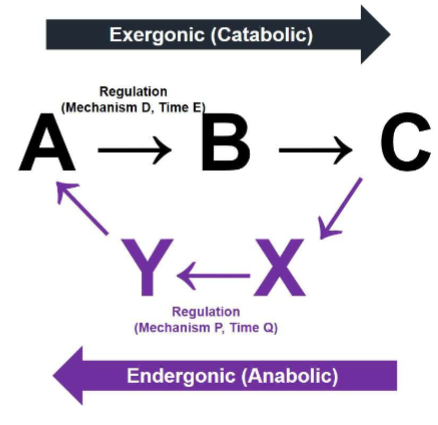
Rate-Limiting Step pt1
Each metabolic process has one or more rate-limiting steps.
Most rxns in a pathway operate near equilibrium (forward and reverse reactions both occur).
Highly exergonic, irreversible reactions act as rate-limiting steps to ensure the pathway produces the desired product.
These steps control the overall speed + direction of the metabolic process.
can turn substrate to product & product to substrate
Rate-Limiting Step pt2
I. Control overall speed at which whole metabolic process proceeds (i.e., rate-limiting step)
II. Can force a metabolite to continue down specific metabolic pathway/cycle/spiral by making metabolic rxn irreversible in nature (i.e., committed step)
Speed determined by R.L.S.
Rate-Limiting Step pt3
Typical points of regulation for metabolic process
A. Regulation occurs by controlling enzymes catalyzing these steps
1. Controlling rate-limiting enzymes also effects activity of other enzymes involved in metabolic process (indirectly effects other enzymes)
Rate-Limiting Step pt4
I. Metabolic processes regulated to meet supply & demand living organisms have for specific metabolites, & maintain overall cellular & organismal homeostasis
reversible step A-B, irreversible step b→C, RLS move in single direction
what makes irreversible is large delta G

Metabolic Regulation
I. Metabolic process regulated via controlling activity of its enzymes (usually its rate-limiting enzymes)
II. Major ways to control enzyme activity
A. Noncovalent interactions (short-term)
B. Covalent modifications (short-term)
C. Enzyme expression changes (long-term)
Noncovalent Interactions pt1
Substrate availability: Below saturation, ↑[substrate] → ↑enzyme activity.
Substrate cooperativity: In multi-site enzymes, binding at one site affects binding at others (positive or negative).
Noncovalent Interactions pt2
Allosteric regulation: Effectors bind allosteric sites, changing enzyme activity.
Allosteric activators: Increase catalytic activity
K-type: ↓KM, V-type: ↑Vmax.
Allosteric inhibitors: Decrease catalytic activity
K-type: ↑KM, V-type: ↓Vmax
Rate limiting enzymes ususally allosteric enzymes
Noncovalent Interactions pt3
Major allosteric effectors:
Substrates (allosterically controlling something towards the end: feedforward stimulation) and end products (feedback inhibition) regulate enzymes.
High-energy molecules (ATP, acetyl-CoA, citrate, NADH): stimulate anabolism, inhibit catabolism.
Low-energy molecules (ADP, AMP): stimulate catabolism, inhibit anabolism.
Noncovalent Interactions
A) represent feedback inhibiton, converting A→E, E can go back and inhibit any further production
B) cellular energy status indicators, if got a lot of ADP so it can stimulate A→B to make ATP can inhibit rxn
C)Feedforward stimulation: A→B be substrate and effector for enzyme ensuring rxn moves foward
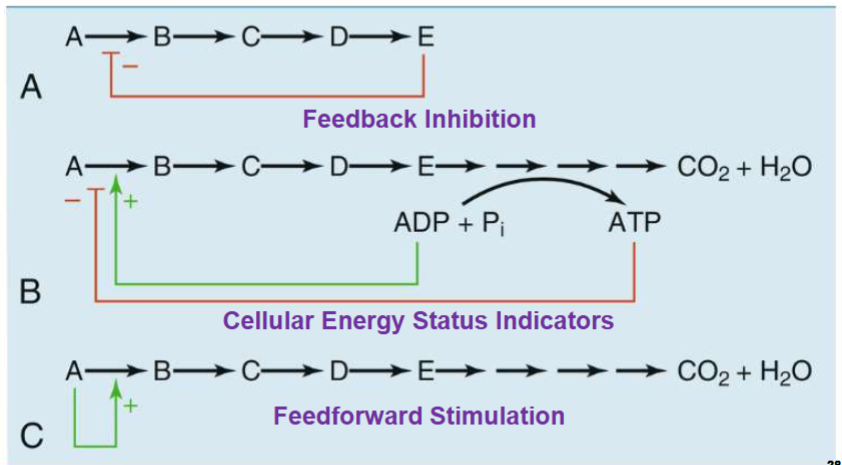
Noncovalent Interactions pt4
Regulatory proteins bind to enzymes
A. Binding may activate or inhibit enzyme function
when protein bind makes it stable, when inhibitory close enzyme shape
Covalent Modification
Phosphorylation & dephosphorylation
A. Enzymes can be phosphorylated by kinases & dephosphorylated by phosphatases
1. Either of these can be stimulatory or inhibitory on enzyme function
Covalent Modification pt2
Limited proteolysis
A. Cleavage of a specific AA-segment of a zymogen (inactive form of enzyme) —> activation of enzyme function
common for digestive enzymes
Enzyme Expression Changes
I. Induction or suppression of enzyme gene transcription
II. Enzyme mRNA maturation or degradation
III. Induction or suppression of enzyme translation
IV. Induction or suppression of enzyme degradation
V. Induction or suppression of enzyme sequestration
Extracellular Control pt1
Enzyme control in the body: Mediated by extracellular signals (e.g., hormones, autacoids
Signals bind plasma membrane receptors (trigger signal transduction cascades) or intracellular receptors (control gene transcription)
Extracellular Control pt2
Most important hormonal controllers:
A. Insulin: stimulates utilization of dietary nutrients
B. Glucagon: maintains blood nutrient levels (e.g., glucose) during fasting
C. Epinephrine & norepinephrine: released during acute stress & physical exertion, stimulating mobilization of stored nutrients
D. Cortisol: released during more prolonged stress, stimulating nutrient presence & utilization (make sure brain is fed)
Cascades & SIgnal Amplification
benefit of multiple steps allows for control at multiple places
allows for amplification
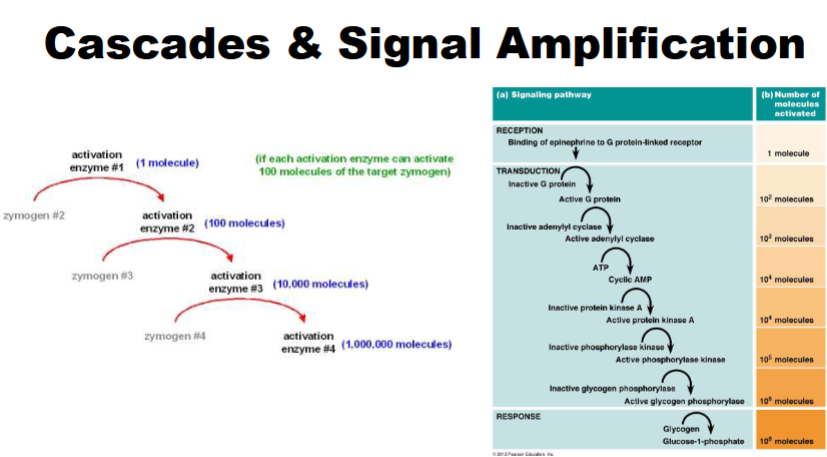
goes through everything for metabolism regulation
look at key for regulations
overview look at
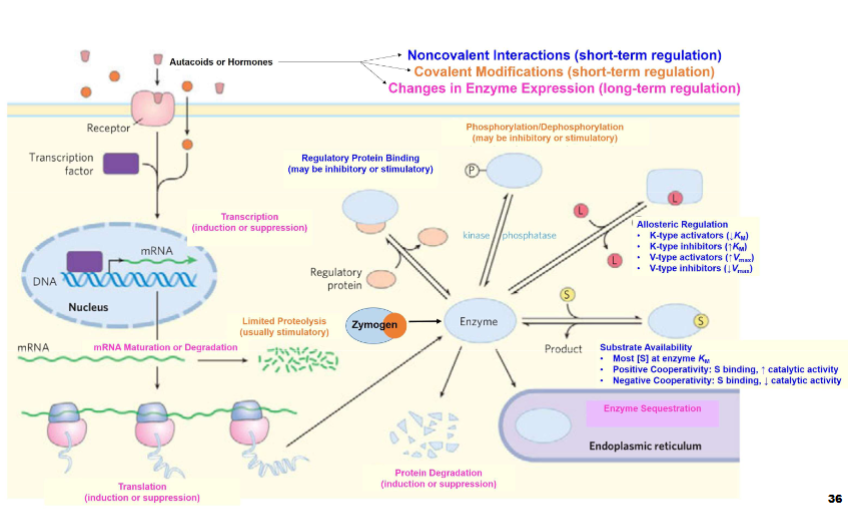
Branch Point Connections
Metabolic branch points: Where many Metabolites processes overlap (reason they overlap is bc they share metabolites)
Fate depends on organism’s current needs, directed by metabolic regulation (metabolites that have >1 potential metabolic fate)
4 branch point connections example
1) gluco 6 phos. (use itn glycolysis—> make pyruvate, can make glucose, can make glycogen, can make pentophosphate,) different ways to make gluco 6 phos. too)
Succinyl-coa can make tca also can make heme
(be familar with it will be good to know for future)
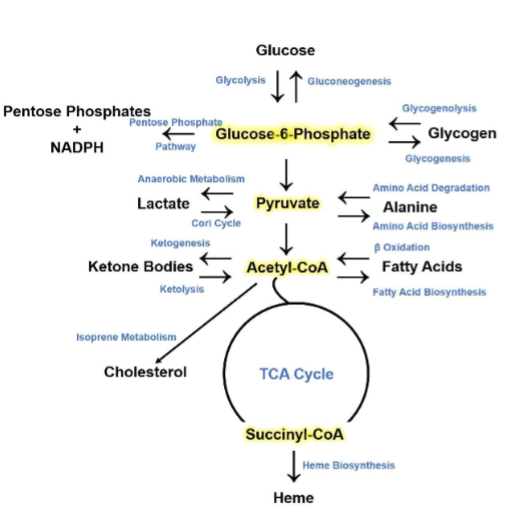
Metabolic specialization pt1
Each cell, tissue, and organ has metabolic processes tailored to its specific functions
Metabolic specialization pt2
I. Digestion of chemical nutrients → small intestine (+++), mouth/stomach (++)
II. Absorption of chemical nutrients → small intestine (only)
III. Glycolysis → all cells IV. Gluconeogenesis → liver (+++), kidney - only happens when u dont eat for a lonnng time(++)
V. TCA cycle & oxidative phosphorylation → all cells (except for RBCs), adipose (small amount)
(+): happens often here
—>: where it happens
Metabolic specialization pt3
I. Anaerobic glycolysis (lactate synthesis) → muscle/RBCs (+++), skin/kidney/brain/intestine (+)
II. Glycogen metabolism (making glyco. and break down) → liver/muscle (+++), brain/kidney/adipocyte (+)
III. Pentose phosphate pathway → all cells, liver/RBCs (+++)
IV. Fatty acid oxidation → liver (prefers fat)/muscle/heart/kidney (+++), brain/adipocytes/RBCs (none)-cant use fatty acids as fuel source
V. Lipogenesis (how u store fat for future use)→ small intestines/liver (++), adipose (+++)-where you store it
VI. Lipolysis → adipose (+++)-only in here
(+): happens often here
—>: where it happens
Metabolic specialization pt4
I. Ketogenesis → liver (only)
II. Ketolysis → muscle/heart (+++), brain (only under fasting/starving conditions, +++), kidneys (++), adipocytes (+), liver/RBCs (none)
III. Amino acid catabolism → liver/kidney (+++), muscle/intestines (++), other cells (+/-)-may happen or may not
IV. Urea cycle → liver (only)
(+): happens often here
—>: where it happens
Metabolic Compartmentation pt1
Metabolic compartmentation: Different metabolic processes occur in separate cell compartments (organelles)
enabling opposite processes to happen simultaneously and allowing precise regulation
Metabolic Compartmentation pt2
Mitochondrion → TCA cycle, electron transport chain, oxidative phosphorylation, fatty acid oxidation, amino acid catabolism, urea cycle (partial), ketogenesis, ketolysis, steroid hormone synthesis (partial), gluconeogenesis (partial)
notice primary place burn fuel (sugar, fat, ketone bodies, and some fuel creation)
Metabolic Compartmentation pt3
Cytosol → glycolysis, pentose phosphate pathway, cholesterol synthesis (partial), eicosanoid synthesis (lipid signally molecules), gluconeogenesis (most), urea cycle (partial), nucleotide synthesis, protein synthesis, phospholipid degradation (some)
Metabolic Compartmentation pt4
I. Lysosome → enzymatic digestion of cell components & ingested materials
intracellular digestion occurs in lysosome
II. Nucleus → DNA replication, transcription, RNA processing
III. Golgi apparatus → posttranslational processing of membrane & secretory proteins, formation of plasma membrane & secretory vesicles, sphingolipid metabolism
can create and degrade sphingolipids
Metabolic Compartmentation pt5
I. Rough endoplasmic reticulum → synthesis of membrane-bound & secretory proteins
II. Smooth endoplasmic reticulum → cholesterol synthesis (partial), steroid hormone synthesis (partial), lipogenesis, phospholipid synthesis, detoxification reactions (main for liver cells/hepatocytes)
III. Peroxisome → oxidative reactions, where burn very long-chain & branched-chain fatty acid oxidation (cant burn in mitochondria)
Inborn Errors of Metabolism
Inherited enzyme deficiencies: Rare, usually recessive; heterozygotes are normal.
Cause disease by substrate buildup and/or product deficiency.
Storage diseases: Defective catabolic pathways lead to abnormal macromolecule accumulation (storage of it)-ex:glycogen storage disease,lysosomal storage disease
Some deficiencies affect only certain tissues due to tissue-specific enzyme isoforms
inborn errors in metabolism ex
1) if have deficiencies on enzyme form c to d options: can make other things or accum. im blood)
b) pathway for nutient, in have enzyme for B pathway for pathway compromised so whole pathway for fuel compromised
c) breaking down macromolecule, diffecency in enzyme c can only break down to certain point
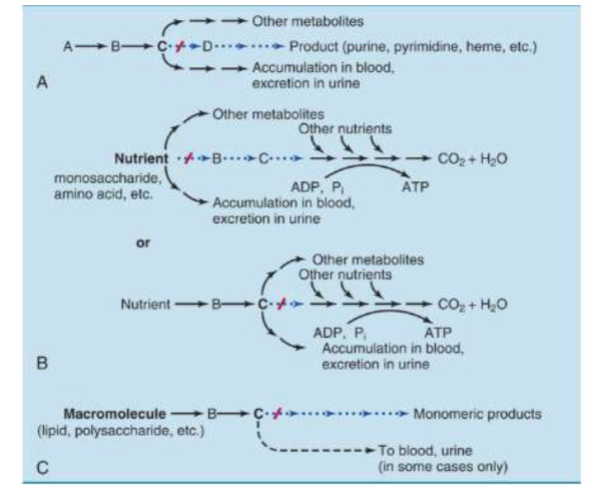
Other Metabolic Problems pt1
Toxins: Can inhibit metabolic enzymes (e.g., lead (Pb) inhibits heme synthesis, cyanide inhibits ATP production).
Vitamin deficiencies: Disrupt metabolism since many vitamins are enzyme coenzymes (e.g., B vitamin deficiency impairs energy metabolism
Other Metabolic Problems pt2
Endocrine disorders: Hormonal abnormalities cause complex metabolic diseases.
Example: Insulin deficiency (type 1) or resistance (type 2) disrupts nearly all carbohydrate and fat metabolism